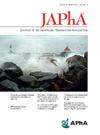数字健康亭是可接受的,可用的,并且在老年人使用时可以改善对高风险非处方药的决策:形成性用户测试的结果。
IF 2.5
4区 医学
Q3 PHARMACOLOGY & PHARMACY
Journal of the American Pharmacists Association
Pub Date : 2025-06-11
DOI:10.1016/j.japh.2025.102451
引用次数: 0
摘要
背景:老年人使用抗胆碱能药物与风险增加有关。尽管非处方(OTC)抗胆碱能药物广泛使用,但减少老年人抗胆碱能药物使用的干预措施主要集中在处方抗胆碱能药物的处方化上,而很少关注OTC抗胆碱能药物。面向消费者的健康技术在社区药房设置可能会减少老年人的OTC抗胆碱能药物的使用。目的:评估老年人对数字健康干预提高OTC用药安全性的态度和行为。方法:在控制性可用性测试中,三组老年人参与者(总N = 13)被单独展示并使用信息亭原型。每位参与者按随机顺序完成三个OTC药物决策场景;如果选择抗胆碱能产品,他们的决定被记录下来,并被认为是不安全的。问卷调查评估了人们对信息亭可用性和可接受性的看法。结果:在第一组测试者(n = 9)之后给予后续提示的参与者中,100%的人使用售货亭来帮助他们做出非处方药的决定。只有5名参与者(38%)在没有提示的情况下使用了自助售货机。最初决定的不安全药物比例为37%,而最终决定的不安全药物比例为4%,这一变化可归因于kiosk的使用。自我报告的可用性和可接受性得分很高,85%的人表示,如果有机会,他们至少会“适度地”使用自助服务亭。结论:设计一个减少OTC抗胆碱能药物使用的信息亭对老年人是可用和可行的,但最初可能不使用。当使用时,信息亭和相关的数字解决方案可以导致更安全的OTC药物决策。这项研究受到样本量小和受控的实验室环境的限制。需要进一步的工作来检查实际OTC决策情景中的初始吸引力和持续的用户参与。本文章由计算机程序翻译,如有差异,请以英文原文为准。
A digital health kiosk is acceptable, usable, and improves decisions about high-risk over-the-counter medications when used by older adults: Results of formative user testing
Background
Older adults' use of anticholinergic medications is associated with increased risks. Despite widespread use of over-the-counter (OTC) anticholinergics, interventions to decrease older adults' anticholinergic use have focused mainly on deprescribing of prescription anticholinergics, with little attention to OTC anticholinergics. Consumer-facing health technology in community pharmacy settings may decrease older adults' OTC anticholinergic use.
Objective(s)
Evaluate older adults' attitudes and behaviors toward a digital health intervention for increasing OTC medication safety.
Methods
In 3 groups, older adult participants (total N = 13) were individually shown and used an information kiosk prototype during controlled usability testing. Each participant completed 3 OTC medication decision scenarios in randomized order; their decisions were recorded and deemed unsafe if an anticholinergic product was selected. Scaled-response surveys assessed perceptions of kiosk usability and acceptability.
Results
Among participants given subsequent prompting after the first group of testers (n = 9), 100% used the kiosk to aid their OTC medication decisions. Only 5 participants (38%) used the kiosk without prompting. Initial decisions had a 37% rate of unsafe medications, whereas 4% of final decisions were unsafe, a change attributable to kiosk use. Self-reported usability and acceptability scores were high, with 85% reporting they would, given the opportunity, use the kiosk at least “a moderate amount.”
Conclusion
A kiosk designed to reduce use of OTC anticholinergic medications is usable and feasible for older adults but may not initially be used. When used, kiosks and related digital solutions can lead to safer OTC medication decisions. This study is limited by its small sample size and controlled, lab-based setting. Further work is needed to examine initial attraction and sustained user engagement in real-world OTC decision scenarios.
求助全文
通过发布文献求助,成功后即可免费获取论文全文。
去求助
来源期刊
CiteScore
3.30
自引率
14.30%
发文量
336
审稿时长
46 days
期刊介绍:
The Journal of the American Pharmacists Association is the official peer-reviewed journal of the American Pharmacists Association (APhA), providing information on pharmaceutical care, drug therapy, diseases and other health issues, trends in pharmacy practice and therapeutics, informed opinion, and original research. JAPhA publishes original research, reviews, experiences, and opinion articles that link science to contemporary pharmacy practice to improve patient care.

 求助内容:
求助内容: 应助结果提醒方式:
应助结果提醒方式:


